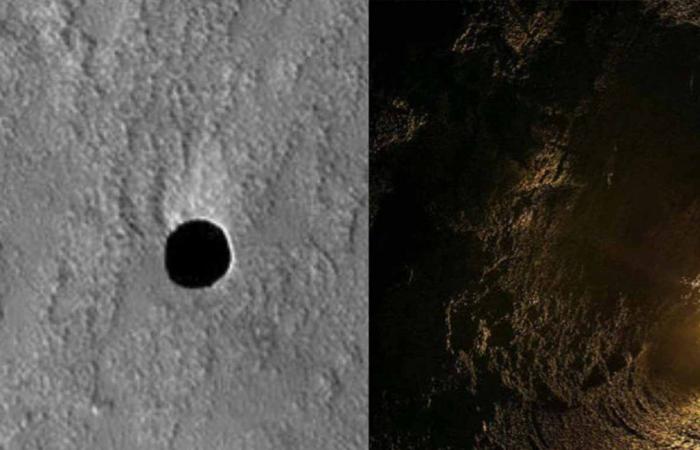
On Mars, a planet that has always fascinated scientists and curious alike, there are several holes on its surface that remain an enigma. These holes, observed for more than a decade, are located on the flanks of ancient volcanoes in the Tharsis region, the largest volcanic area on the red planet and home to some of the most imposing volcanoes in the solar system.
An image taken in 2022 by the HiRISE camera and recently published by the University of Arizona has revived interest in these mysterious formations. Although Mars no longer shows signs of volcanic activity, the presence of these holes suggests that there could be underground lava structures dating back to times when the planet was volcanically active according to scientists.
Scientists believe these holes, also known as shafts, are “skylights,” where the ground above ancient lava tubes has collapsed, leaving huge cavities on the surface. Brandon Johnson, a geophysicist at Purdue University, explained that these lava tubes could be comparable to those we find on Earth.
On our planet according to scientists, these tubes can be large enough to walk through, although they can also be small or have discontinuous voids. This raises an interesting possibility: If the lava tubes on Mars are similar, they could provide natural shelters for future human missions, protecting astronauts from intense Martian radiation.
Scientists are trying to know what options there are for extraterrestrial life in that hole on Mars
“It’s not just one or two of these wells that we’ve found on Mars,” Johnson notes. “They are numerous and could offer safe places for astronauts.” However, the depth and extent of these holes remain unknown to scientists. Observations from orbiting cameras are not enough to determine what is really beneath the surface.
Ross Beyer, a planetary scientist at the SETI Institute, has highlighted that these holes could open into larger caves or simply be isolated pits. “There’s no way to know what they contain until we explore them in more detail,” Beyer said. To better understand these enigmas, direct exploration would be necessary, which involves sending rovers equipped to descend and analyze these wells from within.
Beyond its potential for scientists such as human shelters, these holes could be key in the search for extraterrestrial life according to scientists. Conditions in lava tubes on the Moon, for example, can reach temperatures of up to 63°F, which is enough to support life. If conditions in Martian lava tubes were similar, they could offer a warm and protected environment from the planet’s hostile surface.
The only one detailed information that scientists What they have about these holes comes from images captured by HiRISE, the camera aboard NASA’s Mars Reconnaissance Orbiter. Launched in 2005, HiRISE is the most powerful telescope to ever leave Earth’s orbit, and its more than 80,000 images have transformed our understanding of Mars. However, these images have limitations. “Unfortunately, there is a limit to the ‘angle’ we can get from orbit to look ‘into’ these wells. So sometimes we can see ‘walls’ and sometimes we can’t,” Beyer explained.
The idea of sending a robot to physically investigate these skylights has been proposed, but remains a future project. A robot equipped to descend and explore the interior of lava tubes could provide crucial data on their structure and potential to host life. However, as Johnson clarified, the possibility of finding life in these wells does not guarantee that Mars hosts extraterrestrial life according to scientists.
“This is a good place to look, but we don’t know if there is life on Mars,” Johnson emphasized. In the meantime, missions like HiRISE and other spacecraft orbiting Mars will continue to image these volcanic areas to try to better characterize them.
The mysterious holes in Mars They continue to be a topic of great interest and speculation. They represent both a scientific challenge and a promise for future exploration, with the potential to provide shelter for humans and perhaps even discover extraterrestrial life forms. The exploration of these wells could open a new window to the understanding of Mars’ volcanic past and its ability to sustain life, becoming a priority objective for future space missions.





